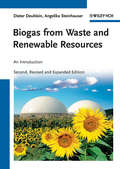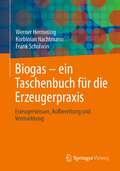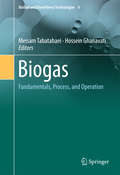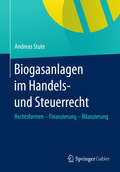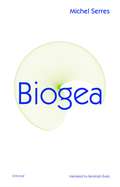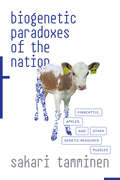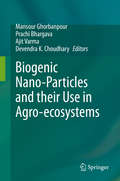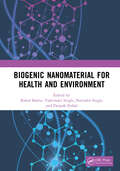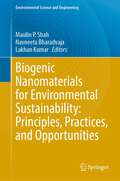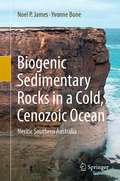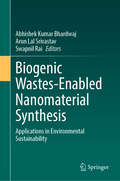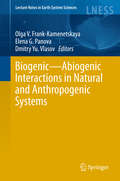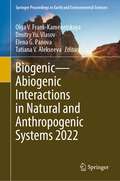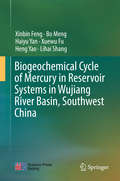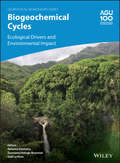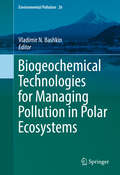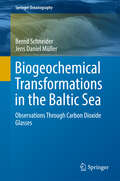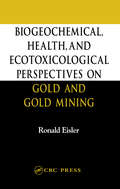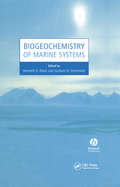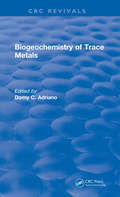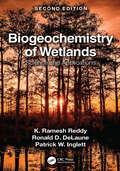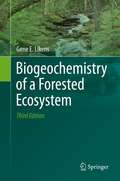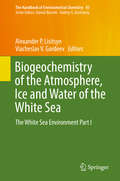- Table View
- List View
Biogas from Waste and Renewable Resources: An Introduction
by Angelika Steinhauser Dieter DeubleinThe leading book on the market just got better: With its unique approach covering all aspects of setting up and running a biogas plant, this new edition has been expanded to include recent advances in biomass processing.The author is a key player in the field, who has designed numerous small- and industrial-scale biogas plants, and who is also a long-time lecturer on biogas production, thus combining didactical skill with real-life expertise. As such, he covers both the biological and technical aspects of biogas generation. The full range of biogas substrates and processing modes is explained, from agricultural and industrial waste to marine algae and sediment. On-site use of biogas for conversion into electricity, fuel and heat is also discussed, as are safety and regulatory issues. Many real-life examples of European biogas plants already in operation illustrate the contents, as do numerous schemes, diagrams and summary tables.For this new edition, biogas analytics and quality control required for feeding biogas into natural gas networks are included, as is a completely new chapter on the microbiology of biogas-producing bacterial communities.
Biogas – ein Taschenbuch für die Erzeugerpraxis: Erzeugerwissen, Aufbereitung und Vermarktung
by Frank Scholwin Werner Hermeling Korbinian NachtmannDieses Buch hilft bei der Entscheidungsfindung zur Verwertung von Biogas. Ausgehend von den verschiedenen Gasreinigungsprozessen wird der Prozess der weiteren Verwertung beschrieben. Das betrifft zum einen die Kompression zu Bio-CNG und zum anderen die Verflüssigung zu Bio-LNG. Die Prozesse werden technisch wie betriebswirtschaftlich und unter ökologischen Gesichtspunkten dargestellt. Unterschiedliche Substrate zur Biogaserzeugung sowie passende Wertschöpfungsketten sind beschrieben. Ein eigener Abschnitt ist der Anlagensicherheit und der Personalschulung gewidmet. So sind sowohl die bisher konventionellen Aufbereitungsverfahren erläutert als auch die Einsatzgebiete der nach der Aufbereitung erhaltenen Produkte Methan (CH4) und Kohlendioxid (CO2) vorgestellt und bewertet worden.
Biogas: Fundamentals, Process, And Operation (Biofuel and Biorefinery Technologies #6)
by Meisam Tabatabaei Hossein GhanavatiThis book presents the state of the art in biogas production using anaerobic digestion technology, with an emphasis on waste utilization/valorization. Offering a comprehensive reference guide to biogas production from different waste streams, it covers various aspects of anaerobic digestion technology from the basics, i.e., microbiological aspects to prominent parameters governing biogas production systems, as well as major principles of their operation, analysis, process control, and troubleshooting. Written and edited by internationally recognized experts in the field of biogas production from both academia and industry, it provides in-depth and cutting-edge information on central developments in the field. In addition, it discusses and reviews major issues affecting biogas production, including the type of feedstock, pretreatment techniques, production systems, design and fabrication of biogas plants, as well as biogas purification and upgrading technologies. ‘Biogas: Fundamentals, Process, and Operation’ also addresses the application of advanced environmental and energy evaluation tools including life cycle assessment (LCA), exergy, techno-economics, and modeling techniques. This book is intended for all researchers, practitioners and students who are interested in the current trends and future prospects of biogas production technologies.
Biogasanlagen im Handels- und Steuerrecht: Rechtsformen – Finanzierung – Bilanzierung
by Andreas StuteDieses Buch dient als Leitfaden für die Abbildung des betrieblichen Geschehens von Biogasanlagen sowohl im Handelsrecht als auch im Steuerrecht. Von der Gründung und Wahl der Rechtsform über die Finanzierungsphase zu den Herstellungs-, Vertriebs- und Verwaltungsprozessen werden wichtige Fragen immer mit Blick auf die bilanzielle Abbildung beantwortet. Der Aufbau des Buches orientiert sich chronologisch an diesen verschiedenen Phasen, sodass Praktiker, Buchhalter und steuerliche Berater jederzeit die richtige Hilfestellung finden. Zahlreiche Berechnungsbeispiele und Vorlagen machen das Werk zu einer wertvollen Arbeitshilfe.
Biogea (Univocal)
by Michel SerresBiogea is a mixture of poetry, philosophy, science, and biography exemplary of the style that has made Michel Serres one of the most extraordinary thinkers of his age. His philosophical and poetic inquiry sings in praise of earth and life, what he names singularly as Biogea. In these times when species are disappearing, when catastrophic events such as earthquakes and tsunamis impale the earth, Serres wonders if anyone &“worries about the death pangs of the rivers.&” And for Serres, one can ask the same question of philosophy as the humanities increasingly find themselves in need of defenders. Today, all living organisms discover themselves part of this Biogea. &“Today we have other neighbors, constituents of the Biogea: the sea, my lover; our mother, the Earth, becomes our daughter; this beautiful breeze which inspires the spirit, a spiritual mistress; our light friends, the fresh and flowing waters.&”
Biogenetic Paradoxes of the Nation: Finncattle, Apples, and Other Genetic-Resource Puzzles (Experimental Futures)
by Sakari TamminenIn 1992, the Convention on Biological Diversity (CBD), signed by over 160 countries and hailed as the key symbol of a common vision for saving Earth's biodiversity, set forth three primary mandates: preserving biodiversity, using biodiversity components sustainably, and enabling economic benefit-sharing. The CBD—which gave signatory countries the ability to claim sovereignty over nonhuman genetic resources native to each nation—defined biodiversity through a politics of nationhood in ways that commodified genetic resources. In Biogenetic Paradoxes of the Nation Sakari Tamminen traces the ways in which the CBD's seemingly compatible yet ultimately paradox-ridden aims became manifest in efforts to create, conserve, and capitalize on distinct animal and plant species. In using Finland as a case study with which to understand the worldwide efforts to convert species into manifestations of national identity, Tamminen shows how the CBD's policies contribute less to biodiversity conservation than to smoothing the way for frictionless operation of biotechnologically assisted circuits of the global bioeconomy. Tamminen demonstrates how an intimate look at the high-level politics and technical processes of defining national genetic resources powerfully illuminates the limits of anthropocentric biopolitical theory.
Biogenic Nano-Particles and their Use in Agro-ecosystems
by Ajit Varma Devendra K. Choudhary Mansour Ghorbanpour Prachi BhargavaSeveral nano-scale devices have emerged that are capable of analysing plant diseases, nutrient deficiencies and any other ailments that may affect food security in agro-ecosystems. It has been envisioned that smart delivery systems can be developed and utilised for better management of agricultural ecosystems. These systems could exhibit beneficial, multi-functional characteristics, which could be used to assess and also control habitat-imposed stresses to crops.Nanoparticle-mediated smart delivery systems can control the delivery of nutrients or bioactive and/or pesticide molecules in plants. It has been suggested that nano-particles in plants might help determine their nutrient status and could also be used as cures in agro-ecosystems. Further, to enhance soil and crop productivity, nanotechnology has been used to create and deliver nano fertilizers, which can be defined as nano-particles that directly help supply nutrients for plant growth and soil productivity. Nano-particles can be absorbed onto clay networks, leading to improved soil health and more efficient nutrient use by crops. Additionally, fertilizer particles can be coated with nano-particles that facilitate slow and steady release of nutrients, reducing loss of nutrients and enhancing their efficiency in agri-crops. Although the use of nanotechnology in agro-ecosystems is still in its early stages and needs to be developed further, nano-particle-mediated delivery systems are promising solutions for the successful management of agri-ecosystems. In this context, the book offers insights into nanotechnology in agro-ecosystems with reference to biogenic nanoparticles. It highlights the: • occurrence and diversity of Biogenic Nanoparticles• mechanistic approach involved in the synthesis of biogenic nanoparticles• synthesis of nanoparticles using photo-activation, and their fate in the soil ecosystem• potential applications of nanoparticles in agricultural systems• application and biogenic synthesis of gold nanoparticles and their characterization• impact of biogenic nanoparticles on biotic stress to plants• mechanistic approaches involved in the antimicrobial effects and cytotoxicity of biogenic nanoparticles• role of biogenic nanoparticles in plant diseases management• relevance of biological synthesized nanoparticles in the longevity of agricultural crops • design and synthesis of nano-biosensors for monitoring pollutants in water, soil and plant systems• applications of nanotechnology in agriculture with special refer to soil, water and plant sciencesA useful resource for postgraduate and research students in the field of plant and agricultural sciences, it is also of interest to researchers working in nano and biotechnology.
Biogenic Nanomaterial for Health and Environment
by Narinder Singh Rahul Badru Yadvinder Singh Deepak DubalThe book titled Biogenic Nanomaterial for Health and Environment covers the synthesis, characterization, and applications of nanomaterials synthesized using living organisms, like bacteria, algae, fungi, plants, and biomolecules derived from them. This book is intended to meet the needs of undergraduate and graduate-level students of chemistry, biology, nanotechnology, and chemical engineering disciplines. The book will also serve as a useful reference work for researchers working in the fields of nanochemistry, material science, biology, and industrial chemistry. FEATURES A systematic overview of the biogenic synthesis nanomaterial. Recent research results and pointers to the advancement in the field. Discussion of putative applications of biogenic nanomaterials in health and the environment, with a main emphasis on biocidal activity, disease diagnosis, drug delivery, and sensing and remediation of pollutants from the environment. This book is compiled in such a way that it aids in understanding the underpinning concepts of the biogenic synthesis of nanoparticles. The biogenic synthesis of nanoparticles delivers more important and effective prospects for nanotechnology researchers. The biomass derived from various organisms acts as a template for the synthesis of nanoparticles with desired structural and featural aspects. The rewards of employing biomass and molecules derived from organism of choice in the synthesis process of nanoparticles are able to enhance the electrochemical consistency, control particle size, reduce toxicity, and escalate reactivity in an eco-friendly way. This book will provide the latest insights into the synthesis of nanomaterials employing biomass, cell extract, or as a whole, of various organisms and their roles in the health and remediation of the environment.
Biogenic Nanomaterials for Environmental Sustainability: Principles, Practices, and Opportunities (Environmental Science and Engineering)
by Maulin P. Shah Navneeta Bharadvaja Lakhan KumarEnvironmental pollution is a worldwide concern now. A major section of the world population is struggling for drinking water. Polluted soil is resulting into low agricultural productivity and thus creating challenges in the way of sustainable livelihood of a large section of human population. Biological treatment can offer both green solutions for wastewater treatment and resource recovery as well. Like algal-based systems can be utilized for wastewater treatment and production of biofuels from the biomass grown on the wastewater. Bio-based nanomaterials have been extensively studied for their employability in the health care, process optimization, water resource management, dealing with environmental pollutants, biosensors, and many others. Bioprospecting of novel biological agents, bio-based products, and bioresource recovery are paving the way for sustainable development as they are providing local solutions for a number of problems.In this proposed book, we start with the introduction to bio-nanotechnological principles and later on discuss bio-based nanomaterials employability for a diverse range of applications from environment to energy to health care. This book provides with current trends in bio-nanotechnology for anthropogonic purposes, prospects, challenges, and way forward.
Biogenic Sedimentary Rocks in a Cold, Cenozoic Ocean: Neritic Southern Australia
by Noel P. James Yvonne BoneThis book documents and interprets the onshore Cenozoic temperate carbonate depositional system along the southern margin of Australia. These strata, deposited in four separate basins, together with the extensive modern marine system offshore, comprise the largest such cool-water carbonate system on the globe. The approach is classic and comparative but the information is a synthesis of recent research and new information. A brief section of introduction outlines the setting, modern comparative sedimentology offshore, and structure of the Cenozoic onshore. The core of the book is a detailed analysis and illustration of the four Eocene to Pleistocene successions. Deposits range from temperate carbonates, to biosiliceous spiculites, to marginal marine siliciclastics. Each unit is interpreted, as much as possible, based on our understanding of the modern offshore depositional system. A subsequent part concentrates on diagenesis both before and after the late Miocene uplift. It turns out that alteration in the two packages is entirely different. The preceding attributes of each succession are then interpreted on the basis of controlling factors such as tectonics, oceanography, climate, and glaciation of nearby Antarctica. This research has revealed new implications for the interpretation of specific attributes of cool-water carbonate sedimentology that could only be discovered from the rock record. Insights concerning cyclicity, reef mounds, biosiliceous deposition, and trophic resources are detailed in the next section. The concluding part focuses on global comparisons, especially the Mediterranean and New Zealand.
Biogenic Wastes-Enabled Nanomaterial Synthesis: Applications in Environmental Sustainability
by Arun Lal Srivastav Abhishek Kumar Bhardwaj Swapnil RaiThis book encompasses the knowledge about diverse types of advanced functional nanomaterial development using biogenic materials and associated applications along with various types of waste materials. Biomass generated from different industries has been long identified as major organic waste and it is a one of the major sources of contamination in the environment. This book will provide the global scenarios of low-cost biogenic materials and their suitability, pretreatment, and the ways to synthesize different kinds of nanomaterials (NMs) including carbonaceous, organic, inorganic and polymeric methods. The quantitative and qualitative characterization and applications of NMs will also be discussed in this book along with scientific and technical knowledge to manage suitable waste materials for NMs synthesis. Significant gaps and similarities between chemical synthesis and green synthesis along with their mechanism will be covered in detail as a point of comparison. The book will also contain the information on the need of policies required for waste management and option for their utilization along with the sources of their generation. The book also contains latest broad aspects of both practical and theoretical fabrication of metal NPs using biogenic waste materials. An emphasis has been made on the recent research related to advance NPs and their application. This book will be useful for undergraduate students, teachers, engineers and researchers, especially those working in areas of environmental science, material science, physical science, biotechnology, biochemistry and microbiology.
Biogenic--Abiogenic Interactions in Natural and Anthropogenic Systems: Abiogenic Interactions In Natural And Anthropogenic Systems (Lecture Notes in Earth System Sciences)
by Olga V. Frank-Kamenetskaya Elena G. Panova Dmitry Yu. VlasovThis book offers a collection of papers presented at the V International Symposium "Biogenic - abiogenic interactions in natural and anthropogenic systems" that was held from 20-22 October 2014 in Saint Petersburg (Russia). Papers in this book cover a wide range of topics connected with interactions between biogenic and abiogenic components in the lithosphere, biosphere and technosphere. The main topics include: biomineralization in geosystems, geochemistry of biogenic-abiogenic systems, biomineral interactions in soil, minerals in living organisms and biomimetic materials, medical geology, bioweathering and destruction of cultural heritage.
Biogenic—Abiogenic Interactions in Natural and Anthropogenic Systems 2022 (Springer Proceedings in Earth and Environmental Sciences)
by Olga V. Frank-Kamenetskaya Elena G. Panova Dmitry Yu. Vlasov Tatiana V. AlekseevaThe book represents a collection of papers presented at VII International Symposium "Biogenic-abiogenic interactions in natural and anthropogenic systems" that was held on 26-29 September 2022 in Saint Petersburg (Russia). Papers in this book cover a wide range of topics connecting with interactions between biogenic and abiogenic components in lithosphere, biosphere and technosphere. The main regarding topics are following: biomineralization in living organisms and nature-like materials; biomineralization in geosystems; geochemistry of biogenic-abiogenic systems; biomineral interactions in soil; interaction of microorganisms with natural and artificial materials; medical geology; philosophical aspects of interdisciplinary researchs
Biogeochemical Cycle of Mercury in Reservoir Systems in Wujiang River Basin, Southwest China
by Xinbin Feng Bo Meng Haiyu Yan Xuewu Fu Heng Yao Lihai ShangThis book presents an intensive study on the biogeochemical cycle of mercury in a river-reservoir system in Wujiang River Basin, the upper branch of the Yangtze River. Six reservoirs located in the mainstream of the Wujiang River and their corresponding inflow/outflow rivers were selected for inclusion in this study, which was conducted by researchers from the Institute of Geochemistry, Chinese Academy of Sciences. The concentration and distribution of Hg in reservoirs (the water column, sediment, sediment pore water), inflow/outflow rivers of reservoirs, and wet deposition in Wujiang River Basin were systematically investigated, and measurements were taken of the water/air exchange flux of gaseous elemental mercury (GEM). On the basis of the data gathered, a detailed mass balance of total mercury (THg) and methylmercury (MeHg) in the six reservoirs was developed. In addition, the book identifies the primary factors controlling Hg methylation in the river-reservoir system in Wujiang River Basin. The accumulation and bio-magnification of Hg species within food chains in reservoirs and human health risk of MeHg exposure through fish consumption are also included in this book.
Biogeochemical Cycles: Ecological Drivers and Environmental Impact (Geophysical Monograph Series #248)
by Katerina Dontsova Zsuzsanna Balogh-Brunstad Gaël Le RouxBiogeochemical Cycles: Ecological Drivers and Environmental Impact is a collection of the latest information on the techniques and methods currently used in this field, focusing on biological and/or ecological effects of biogeochemical elemental cycles including carbon, nitrogen, major and trace elements, chemical weathering on multiple scales of nanometers to watersheds, and advances in technology of studying these processes.Volume highlights include:- Remote sensing and modeling techniques used to quantify changes in the ecosystem/s productivity, and microscopic techniques to estimate the extent of weathering - Novel isotopic techniques to assess changes in trace elemental cycles as influenced by the changing climate, and plant-mediated effect of climate change on major elemental cycles - Impact of climate change and other anthropogenic influences in agricultural and extreme (frontier) environmentsBiogeochemical Cycles: Ecological Drivers and Environmental Impact is a valuable resource for students, researchers and professionals in the field of biogeosciences, hydrology, ecology, earth and planetary surface processes, volcanology, petrology, geochemistry, mineralogy, soil science, agricultural science, climate change and environmental science.
Biogeochemical Dynamics at Major River-Coastal Interfaces
by Mead A. Allison Thomas S. Bianchi Thomas S. Bianchi Mead A. Allison Wei-Jun CaiThis volume provides a state-of-the-art summary of biogeochemical dynamics at major river-coastal interfaces for advanced students and researchers. River systems play an important role (via the carbon cycle) in the natural self-regulation of Earth's surface conditions by serving as a major sink for anthropogenic CO2. Approximately 90 percent of global carbon burial occurs in ocean margins, with the majority of this thought to be buried in large delta-front estuaries (LDEs). This book provides information on how humans have altered carbon cycling, sediment dynamics, CO2 budgets, wetland dynamics, and nutrients and trace element cycling at the land-margin interface. Many of the globally important LDEs are discussed across a range of latitudes, elevation and climate in the drainage basin, coastal oceanographic setting, and nature and degree of human alteration. It is this breadth of examination that provides the reader with a comprehensive understanding of the overarching controls on major river biogeochemistry.
Biogeochemical Technologies for Managing Pollution in Polar Ecosystems (Environmental Pollution #26)
by Vladimir N. BashkinThis edited book is devoted to environmental risk management in gas industry impacted polar ecosystems of Russia, one of the hottest topics of modern environmental science. The contributions from experts cover topics that shed new light on the impacts of oil and natural gas production on arctic ecosystems in the country as well as biogeochemical engineering technologies to manage pollution in these areas. Readers will also discover new insights on potential ecological indicators for assessing geo-environmental risks of these impacted ecosystems, and climate modeling in polar areas. The book has interdisciplinary appeal, and specialists and practitioners in environmental sciences, ecology, biogeochemistry and those within the energy sector who are interested in understanding ecosystems affected by anthropogenic impacts in severe climatic conditions will find it particularly engaging. Through this book, readers will learn more about biogeochemical cycling through food chains and specific reactions of biota to environmental pollution in extreme environments through the lens of experts.
Biogeochemical Transformations in the Baltic Sea: Observations Through Carbon Dioxide Glasses (Springer Oceanography)
by Bernd Schneider Jens Daniel MüllerThis book provides a comprehensive review of the biogeochemistry in the Baltic Sea. It is based on the fact that biogeochemical processes that are relevant for the ecological state of the Baltic Sea (and other sea areas), are all in some way related to the production and mineralization of organic matter (biomass) and thus are associated with the consumption or release of CO2. The significant progress with regard to our chemical analytical capabilities concerning the marine CO2 system has facilitated new approaches to study the Baltic Sea biogeochemistry, in particular with regard to a quantitative process understanding. To demonstrate this, the authors present the fundamentals of the marine CO2 system in a theoretically sound, but still intelligible way. This is followed by a comprehensive presentation of our current knowledge about the CO2 system in the Baltic Sea and the implications for our understanding of biogeochemical processes such as production/mineralization of organic matter and the stoichiometry involved, nitrogen fixation, denitrification, and phosphate transformations at varying redox conditions. Finally, the CO2 gas exchange balance and related problems such as acidification are addressed.
Biogeochemical, Health, and Ecotoxicological Perspectives on Gold and Gold Mining
by Ronald EislerDespite the esteemed nature of gold in society, evidence of adverse ecotoxicological effects and risk to human health in various mining and extraction techniques has generated increasing interest in the biological and environmental implications of gold. Biogeochemical, Health, and Ecotoxicological Perspectives on Gold and Gold Mining is the first c
Biogeochemistry and the Environment
by Michael O'Neal CampbellBiogeochemistry may be defined as the science that combines biological and chemical perspectives for the examination of the Earth’s surface, including the relations between the biosphere, lithosphere, atmosphere, and hydrosphere. Biogeochemistry is a comparatively recently developed science, that incorporates scientific knowledge and findings, research methodologies, and models linking the biological, chemical, and earth sciences. Therefore, while it is a definitive science with a strong theoretical core, it is also dynamically and broadly interlinked with other sciences. This book examines the complex science of biogeochemistry from a novel perspective, examining its comparatively recent development, while also emphasizing its interlinked relationship with the earth sciences (including the complementary science of geochemistry), the geographical sciences (biogeography, oceanography, geomatics, earth systems science), the biological sciences (ecology, wildlife studies, biological aspects of environmental sciences) and the chemical sciences (including environmental chemistry and pollution). The book covers cutting-edge topics on the science of biogeochemistry, examining its development, structure, interdisciplinary, multidisciplinary, and transdisciplinary relations, and the future of the current complex knowledge systems, especially in the context of technological, developments, and the computer and data fields.
Biogeochemistry of Marine Systems (Sheffield Biological Siences Ser. #20)
by KENNETH D. BLACK; GRAHAM B. SHIMMIELDMarine systems vary in their sensitivities to perturbation. Perturbation may be insidious - such as increasing eutrophication of coastal areas - or it may be dramatic - such as a response to an oil spill or some other accident. Climate change may occur incrementally or it may be abrupt, and ecosystem resilience is likely to be a complex function of the interactions of the factors and species mediating key biogeochemical processes.Biogeochemistry of Marine Systems considers issues of marine system resilience, focusing on a range of marine systems that exemplify major global province types. Each system is interesting in its own right, on account of its sensitivity to natural or anthropogenic change or its importance as an ecological service provider. Each contributing author concentrates on advances of the last decade.This prime reference source for marine biogeochemists, marine ecologists, and global systems scientists provides a strong foundation for the study of the multiple marine systems undergoing change because of natural biochemical or anthropogenic factors.
Biogeochemistry of Trace Metals: Advances In Trace Substances Research (CRC Press Revivals)
by Domy C. AdrianoBiogeochemistry of Trace Metals is a compendium of the most recent information available on the effects of trace metals in soil quality and its potential threat on the transfer of these contaminants to consumers. Most of the chapters in the book were presented as papers during the First International Conference on the Biogeochemistry of Trace Elements (formerly Metals in Soils, Plants, Waters, and Animals) held in Orlando, Florida in May, 1990. Topics discussed include background levels of metals in soils and/or plants (covering western Europe; temperate, humid Europe; and the People's Republic of China); metal cycling and transfer in the food chain in agroecosystems; uptake and accumulation of metals by bacteria, fungi, and invertebrates; mechanistic aspects of metals; the microbial aspects of soil selenium losses; and manganese sorption on soil constituents.
Biogeochemistry of Wetlands: Science and Applications
by K. Ramesh Reddy Ronald D. DeLaune Patrick W. InglettThe globally important nature of wetland ecosystems has led to their increased protection and restoration as well as their use in engineered systems. Underpinning the beneficial functions of wetlands are a unique suite of physical, chemical, and biological processes that regulate elemental cycling in soils and the water column. This book provides an in-depth coverage of these wetland biogeochemical processes related to the cycling of macroelements including carbon, nitrogen, phosphorus, and sulfur, secondary and trace elements, and toxic organic compounds. In this synthesis, the authors combine more than 100 years of experience studying wetlands and biogeochemistry to look inside the black box of elemental transformations in wetland ecosystems. This new edition is updated throughout to include more topics and provide an integrated view of the coupled nature of biogeochemical cycles in wetland systems. The influence of the elemental cycles is discussed at a range of scales in the context of environmental change including climate, sea level rise, and water quality. Frequent examples of key methods and major case studies are also included to help the reader extend the basic theories for application in their own system. Some of the major topics discussed are: Flooded soil and sediment characteristics Aerobic-anaerobic interfaces Redox chemistry in flooded soil and sediment systems Anaerobic microbial metabolism Plant adaptations to reducing conditions Regulators of organic matter decomposition and accretion Major nutrient sources and sinks Greenhouse gas production and emission Elemental flux processes Remediation of contaminated soils and sediments Coupled C-N-P-S processes Consequences of environmental change in wetlands The book provides the foundation for a basic understanding of key biogeochemical processes and its applications to solve real world problems. It is detailed, but also assists the reader with box inserts, artfully designed diagrams, and summary tables all supported by numerous current references. This book is an excellent resource for senior undergraduates and graduate students studying ecosystem biogeochemistry with a focus in wetlands and aquatic systems.
Biogeochemistry of a Forested Ecosystem
by Gene E. LikensThe goal of this Third Edition is to update long-term data presented in earlier editions and to generate new syntheses and conclusions about the biogeochemistry of the Hubbard Brook Valley based on these longer-term data. There have been many changes, revelations, and exciting new insights generated from the longer data records. For example, the impact of acid rain peaked during the period of the HBES and is now declining. The longer-term data also posed challenges in that very marked changes in fluxes occurred in some components, such as hydrogen ion and sulfate deposition, calcium and nitrate export in stream water and biomass accumulation, during the almost 50 years of record. Thus, presenting "mean" or "average" conditions for many components for such a long period, when change was so prominent, do not make sense. In some cases, pentads or decades of time are compared to show these changes in a more smoothed and rational way for this long period. In some cases, a single period, often during periods of rapid change, such as acidification, is used to illustrate the main point(s). And, for some elements a unique mass balance approach, allowing the calculation of the Net Ecosystem Flux (NEF), is shown on an annual basis throughout the study.
Biogeochemistry of the Atmosphere, Ice and Water of the White Sea: The White Sea Environment Part I (The Handbook of Environmental Chemistry #81)
by Alexander P. Lisitsyn Viacheslav V. GordeevThis book is devoted to the biogeochemical environment of the White Sea, an inland sea in the Northwestern region of Russia. It provides a comprehensive review and discusses the latest research findings on the oceanology, sedimentology and biogeochemistry of the White Sea water column. The topics discussed include the regulation of the physico-geographical conditions in the White Sea basin; dispersed sedimentary substance of the atmosphere and the cryosphere; the geochemical peculiarities of the river discharge into the White Sea; and the phyto- and zooplankton activities in the White Sea. Taking the biggest river in the White Sea basin as an example, the authors closely examine the deposition of suspended particulate matter, the biogeochemical behaviour of dissolved and suspended forms of organic material and the significant group of chemical elements in the river-sea mixing zone of the Severnaya Dvina River. The book ends with a summary of the key conclusions and recommendations. Together with the companion volume Sedimentation Processes in the White Sea: The White Sea Environment Part II, it offers an essential source of information for postgraduate students, researchers and stakeholders alike.
